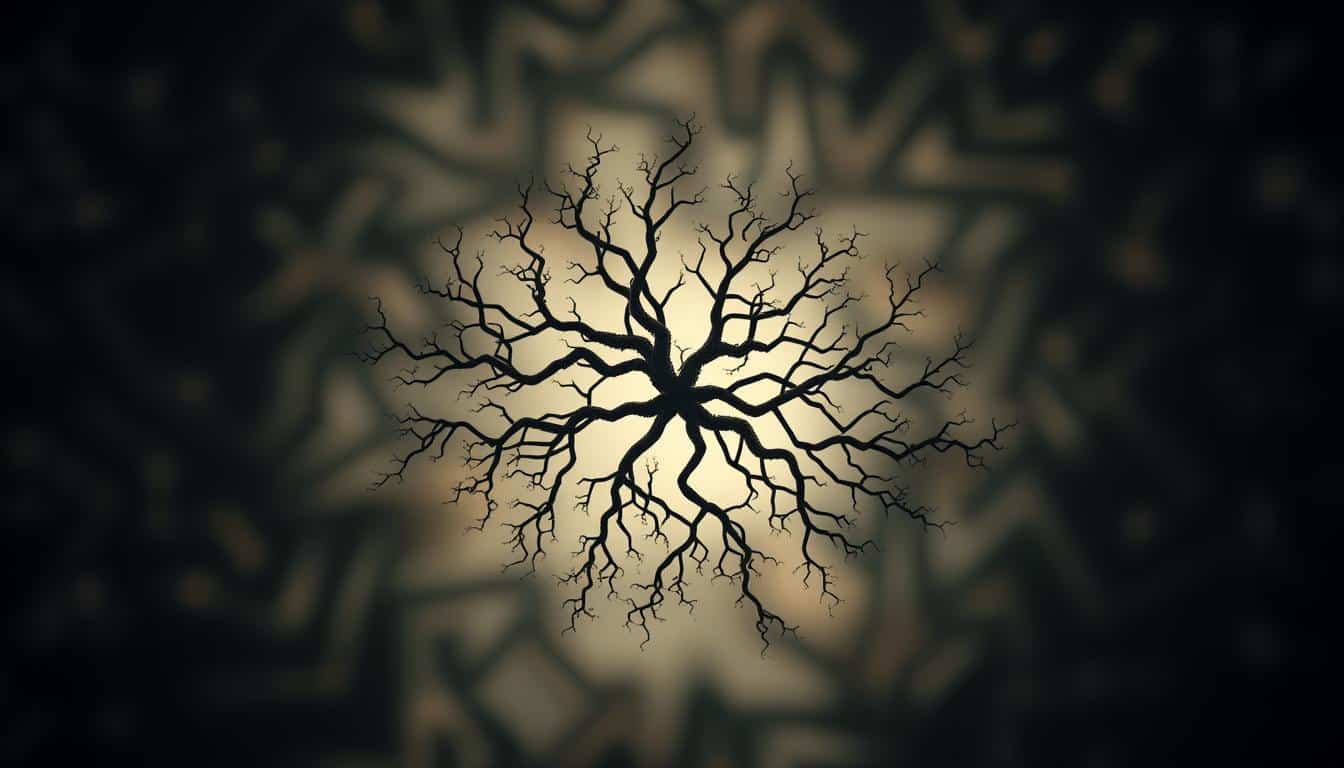Fractal algorithms are making big waves in artificial intelligence and machine learning. They are based on fractal geometry, known for patterns that repeat. These patterns can make computers work better and faster. As tech moves forward, using fractal algorithms could lead to breakthroughs in AI and ML. This article will explore the exciting world of fractals and their role in improving how computers think and learn.
Understanding Fractals: A Brief Overview
Fractals are a key part of math, showing us the cool side of fractal geometry. They are known for self-similarity. This means they show similar shapes at different sizes, packed with endless complexity and special dimensions that aren’t whole numbers.
Fractals help explain why nature looks the way it does, making things work better. For example, the way trees branch out, rivers spread, and coastlines wiggle share fractal traits. The Mandelbrot set is a famous fractal that shows us the stunning complexity and beauty of these shapes.

Learning about fractals doesn’t just boost our math skills. It also opens up new possibilities in tech and scientific research.
The Role of Fractal Algorithms in Artificial Intelligence and Machine Learning
Fractal algorithms are key for AI and machine learning progress. They use fractals’ repeating patterns to better handle complex data. This makes AI applications more advanced.
In areas needing quick data analysis and spotting patterns, these algorithms are crucial. Their repeating nature helps solve problems more efficiently. This boosts machine learning, making models trained this way more accurate and dependable.
The future of AI with fractals looks promising. Emphasizing their patterns could lead to big breakthroughs. By adding fractal algorithms into machine learning, we could greatly change technology. This opens new ways to learn from data and create software.
Fractals in AI: Enhancing Computational Efficiency
Fractal algorithms are key in making AI systems more efficient. They use fractal optimization to cut down the resources needed for big datasets. This way, AI can handle complex data better with less cost.
Using fractal compression is a big plus. It shrinks datasets but keeps the important info. AI tools can then work faster and better, especially in areas like image work and analyzing signals.
Fractal strategies, like recursive algorithms, simplify tough problems. They break big issues into smaller parts, making processing smoother. This speeds up how AI apps make decisions and boosts overall efficiency.
Optimized Problem Solving with Recursive Fractal Structures
Recursive fractal structures are a strong way to tackle complex challenges. They simplify big problems into smaller parts, making solutions clearer. This method is like natural problem-solving steps found in artificial intelligence.
These structures help improve AI algorithms and their ability to predict. By using recursion, patterns stand out, which deepens our understanding of how data relates. The key advantages are:
- Effective management of intricate problems.
- Reduction of computation times due to streamlined processing.
- Flexibility in adapting to dynamic environments.
Recursive fractal structures shine in AI optimization across various fields. For instance, they help forecast market trends in financial modeling by studying past data. In robotics, they enable real-time changes, boosting how well robots can navigate.
Applications of Fractal Algorithms in Pattern Recognition
Fractal algorithms are very useful in the world of pattern recognition. They have a special way of dealing with complex data. This allows them to reveal complicated patterns. This is especially helpful for different AI uses.
Fractal neural networks are great at finding patterns on many levels. This makes image and speech recognition systems more accurate.
Many areas are using these networks, leading to big improvements. For example:
- In medical imaging, fractal algorithms help doctors diagnose diseases better by picking up small changes in images.
- For keeping an eye on the environment, these methods offer enhanced data analysis for ecosystems and weather patterns.
- In financial forecasting, fractal neural networks spot market trends and unusual activity more effectively.
The use of fractal algorithms makes recognition systems better. This is crucial for sparking new advancements in various fields.
Fractal Machine Learning: Key Concepts and Principles
Fractal machine learning uses fractal principles to better analyze and interpret data. It takes key ideas from fractal geometry, like fractal dimension and iterative processes. Through these, it improves the accuracy of predictions and how well models work with different kinds of data.
This approach is great at adjusting to various data types. It builds on adaptive learning, which changes models based on the data’s complexities. This makes the predictive models stronger and more versatile, facing different problems effectively.
By adding fractal features to machine learning, experts can build efficient models that also clearly reveal data patterns. Looking at fractal self-similarity shows how these ideas can make sense of complex data. So, integrating fractal dimensions with machine learning leads to new methods. This offers better insights for analysts and researchers.
Current Research Trends in Fractal Algorithms for AI
More and more, research shows how important fractal algorithms are in AI. Scientists are diving deep into fractal neural networks. They’re seeing how these can make different applications run better. Through this work, they’ve found ways to improve how machines learn, often outdoing older methods.
There’s a mix of experts working together on this—from math, computer science, and engineering. Their teamwork leads to new ways to solve tricky problems using fractals. This teamwork is opening doors for fractals to be used in real AI tools and technologies.
Challenges and Limitations of Implementing Fractal Algorithms
Fractal algorithms have a lot of promise in AI. But, using these methods is not easy. They need a lot of computing power to look at complex patterns. This means they take longer to work and use more resources.
Also, these algorithms struggle with low-quality data. Noise in the data can mess up their results. So, we need good methods to make the data better. This makes sure the data is clean and accurate for the algorithms.
Understanding these algorithms can also be tough. They work in ways that are hard to explain. This makes it tricky to use them where we need to know how decisions are made. People might be slow to accept them because of this.
To sum up, fractal algorithms could change things a lot. But, they face big hurdles. We’re talking about lots of computing power, needing better data, and making them easier to understand. We need more research to overcome these obstacles.
Conclusion
As we end our look into fractal algorithms in AI and machine learning, we see their big impact. These mathematical tools can change the tech world. They make problem solving better and improve recognizing patterns, expanding AI’s abilities.
Understanding fractal algorithms is key, not just a trend. It’s a major step that shapes AI’s future. This area’s research is vital for new breakthroughs. Such work can change how we use intelligent systems.
Fractal algorithms are major game changers in technology, especially for artificial intelligence. They help create smarter AI systems. The role of these algorithms in making top-notch technologies is huge.



